Related Research Articles
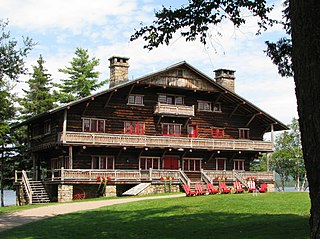
Great Camp Sagamore is one of several historic Great Camps located in the Adirondack Mountains of northern New York State.

Big Moose Lake, at the head of the Moose River, is a large lake about five miles (8 km) north of Fourth Lake in the Adirondacks in upstate New York. The lake is within both Herkimer and Hamilton counties, and covers portions of the towns of Webb and Long Lake. Located southwest of the lake is the hamlet of Big Moose.

The Santanoni Preserve was once a private estate of approximately 13,000 acres (53 km2) in the Adirondack Mountains, and now is the property of the State of New York, at Newcomb, New York.
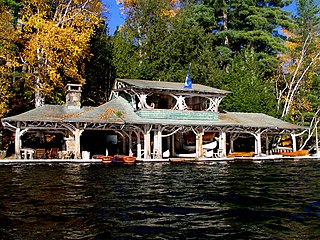
The Great Camps of the Adirondack Mountains refers to the grandiose family compounds of cabins that were built in the latter half of the nineteenth century on lakes in the Adirondacks such as Spitfire Lake and Rainbow Lake. The camps were summer homes for the wealthy, where they could relax, host or attend parties, and enjoy the wilderness. In time, however, this was accomplished without leaving the comforts of civilization behind; some great camps even contained a bowling alley or movie theatre.

Adirondack Architecture refers to the rugged architectural style generally associated with the Great Camps within the Adirondack Mountains area in New York. The builders of these camps used native building materials and sited their buildings within an irregular wooded landscape. These camps for the wealthy were built to provide a primitive, rustic appearance while avoiding the problems of in-shipping materials from elsewhere.
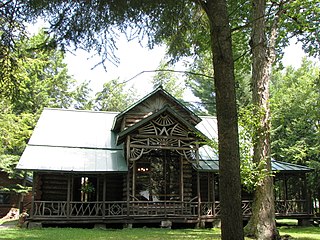
Camp Pine Knot, also known as Huntington Memorial Camp, on Raquette Lake in the Adirondack Mountains of New York State, was built by William West Durant. Begun in 1877, it was the first of the "Adirondack Great Camps" and epitomizes the "Great Camp" architectural style. Elements of that style include log and native stonework construction, decorative rustic items of branches and twigs, and layout as a compound of separated structures. It is located on the southwest tip of Long Point, a two-mile long point extending into Raquette Lake, in the Town of Long Lake in Hamilton County, New York.

William West Durant (1850–1934) was a designer and developer of camps in the Adirondack Great Camp style, including Camp Uncas, Camp Pine Knot and Great Camp Sagamore which are National Historic Landmarks. He was the son of Thomas C. Durant, the financier and railroad promoter who was behind the Crédit Mobilier scandal.

Camp Uncas is an Adirondack Great Camp, the second built by William West Durant for his own use. It lies on the shore of 110-acre (45 ha) Lake Mohegan, near Great Camp Sagamore, and was completed in two years.

Upper Saranac Lake is one of three connected lakes, part of the Saranac River, in the towns of Santa Clara and Harrietstown, near the village of Saranac Lake in the Adirondacks in northern New York. Upper Saranac Lake is the sixth largest lake in the Adirondacks. With Middle Saranac Lake and Lower Saranac Lake, a 17-mile (27 km) paddle with only one carry is possible. There are 20 primitive campsites accessible by boat available on a first-come basis. Upper Saranac Lake is also known as Sin-ha-lo-nen-ne-pus.

Begun in 1882, Camp Wild Air was the first permanent camp on Upper Saint Regis Lake, in the town of Brighton, Franklin County in New York's Adirondacks. The camp was built by New York Herald Tribune publisher Whitelaw Reid on a 29-acre (12 ha) peninsula accessible only by water. It presently consists of 12 buildings, 10 of which were built before 1931.
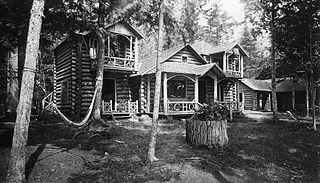
Echo Camp is an Adirondack Great Camp on the tip of Long Point adjacent to Camp Pine Knot on Raquette Lake. It was used as a private girls' camp from the mid-1940s to the mid-1980s. It was sold in 1986, and is now a privately owned summer residence.
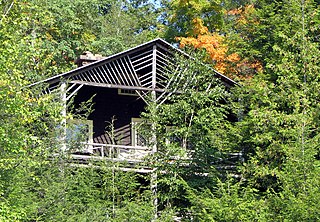
Moss Ledge is an Adirondack Great Camp designed by William L. Coulter in 1898 for Isabel Ballantine of New York City. Ballantine was the granddaughter of Newark beer baron, John Holmes Ballantine.

Prospect Point Camp is an Adirondack Great Camp notable for its unusual chalets inspired by hunting lodges. William L. Coulter's design is a significant example of the Adirondack Rustic style. It is located on a bluff overlooking the northern reaches of Upper Saranac Lake, near Eagle Island Camp and Moss Ledge, two other Coulter designs. Its grand scale is typical of the opulent camps of the area in the great camp era. The camp was built for New York copper magnate and financier Adolph Lewisohn.

William Lincoln Coulter (1865–1907) was an American architect who came to Saranac Lake, New York, in the spring of 1896 in an effort to cure his tuberculosis, and stayed to design some of the finest Adirondack Great Camps and Cure Cottages in the area. Among the camps he designed were Knollwood Club, Camp Eagle Island and Prospect Point Camp; Camp Eagle Island has been designated a US National Historic Landmark. In Saranac Lake, in 1903, he designed a house at 147 Park Avenue for Thomas Bailey Aldrich, editor of the Atlantic Monthly, that wits dubbed "The Porcupine" because it had so many fine points and belonged to a "quill pusher". He also designed the Coulter Cottage, built between 1897 and 1899.

Adirondack Experience, located on NY-30 in the hamlet of Blue Mountain Lake in Hamilton County, New York, is a museum dedicated to preserving the history of the Adirondacks. The museum is located on the site of an historic summer resort hotel, the Blue Mountain House, built high above Blue Mountain Lake in 1876 by Miles Tyler Merwin, that operated until the late 1940s. The museum consists of 23 buildings, 121 acres, and 60,000 square feet of exhibition space. The opening of a brand new 19,000 square foot exhibition, Life in the Adirondacks, took place July 2017.

Pine Tree Point is an Adirondack Great Camp on Upper St. Regis Lake.

William G. Distin (1884–1970), an architect of Saranac Lake, New York, was an early associate of Great Camp designer William L. Coulter who went on to design a number of Adirondack Great Camps.

Utowana Lake is a lake in the Eckford Chain in the Adirondack Mountains of the state of New York. It is connected to Eagle Lake and Blue Mountain Lake to the east and the Marion River/Raquette Lake to the west. It was owned by adventure writer Ned Buntline in 1867 and by William West Durant in 1888 before being purchased by mining magnate Berthold Hochschild in 1904. A significant part of the north shore is still owned by the Hochschild family as part of the Eagle Nest camp; the rest is under conservation easements.
Berthold Hochschild was a mining magnate, a founder of the American Metal Company, and a philanthropist.
Walter Hochschild was an American industrialist, having spent 63 years as an executive with the American Metal Company, founded by his father, Berthold Hochschild.
References
- ↑ Aslet, Clive (2004). The American Country House. Yale University Press. p. 288. ISBN 978-0-300-10505-6 . Retrieved 27 January 2020.
- ↑ Kaiser, Harvey H. (1982). Great Camps of the Adirondacks. David R. Godine Publisher. p. 76. ISBN 978-1-56792-073-4 . Retrieved 27 January 2020.
- ↑ Gilborn, Alice (1975). The Walter Hochschild Camp at Eagle Nest . Retrieved 27 January 2020.
- ↑ Gilborn, Craig (2000). Adirondack Camps: Homes Away from Home, 1850-1950. Syracuse University Press. ISBN 978-0-8156-0626-0 . Retrieved 27 January 2020.
- ↑ "The Walter Hochschild Camp at Eagle Nest". adirondack.pastperfectonline.com. Retrieved 27 January 2020.
- ↑ Alice Gilborn, The Walter Hochschild Camp at Eagle Nest, 1975